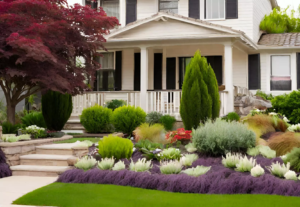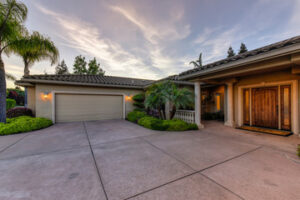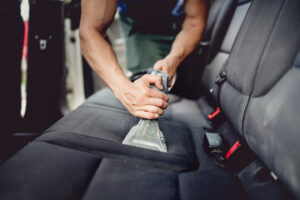Landscaping involves the addition of plants, changes to terrain and construction of structures such as fences, decks and walls. It is important to understand how these elements work together in order to create a harmonious landscape design.
Using the right landscaping techniques can help conserve energy by limiting direct sunlight onto your home during the summertime, keeping it cooler and less expensive to cool. Contact Landscapers Baltimore now!

Color is one of the most powerful tricks in a landscaper’s arsenal, able to evoke emotions, create focal points, and enhance the aesthetics of your outdoor space. When used correctly, it can transform your garden into a work of art by striking the right balance between beauty and function. Learn how to use colors strategically in your landscaping to accentuate your home, draw attention to your favorite plants, and elevate the health of your trees.
Different colors evoke distinct emotions and can have a significant impact on your mood. Warm colors like red, orange, and yellow tend to evoke excitement and energy, while cool colors like blue, green, and purple promote relaxation and tranquility. You can use these principles to your advantage when designing your landscape by planting warm colors together to create a focal point, or using them in contrast to add depth to your garden.
The Color Wheel
Colors are categorized into primary and secondary colors, depending on their origin. For example, the combination of red and yellow produces orange, while the mix of blue and purple results in violet. In landscape design, the color wheel is useful because it shows how complementary colors can be combined to create an appealing palette.
The color spectrum also describes how light or dark a particular hue is, and its intensity. For instance, a Canary yellow rose is lighter than a purple Penstemon, and both are lighter than a blue Delphinium. The value of a color is also important, as it refers to how close it is to white. If you want to create a bright, vibrant garden, consider using plants with higher intensity.
Another way to unify your landscape is by using a monochromatic color scheme. This involves using tints and shades of a single color, such as pastel lavender with royal purple flowers like hydrangeas. Alternatively, you can try using analogous colors, which are a group of three or more closely related colors that blend into each other. For example, you could combine a warm orange like the leaves of a Weeping Willow with yellow and red flowers such as tulips and lilies.
Form
In the landscape, form is the structural foundation of design. It’s the shape of a flower bed, pond or path that controls movement through the garden and highlights different types of design features such as a fire pit, swimming pool or gazebo. Form can also be the shape of a plant or the shapes created by hardscape materials like pavers or natural stone. Form is an essential element of a successful landscape, but it must be balanced with color and texture for harmony.
Line is a primary element of the composition of any landscape. It represents boundaries and movement and can direct the eye to a focal point or distract from something you want to hide. It can take many forms – straight, curved, vertical, horizontal or diagonal – and is used throughout the yard in the edging of paths and walkways, the perimeter of turf areas, and the outline of hardscape structures. Lines are used to create planes, and multiple planes can create volume in a space.
Unlike color, form is an enduring characteristic that lasts beyond a growing season. While a single specimen with an appealing form may be enough to make a statement in a design, repetition of the same shape helps create a theme that unifies a garden. A garden with too much repetition can become monotonous, but simple repetition can work well if the repeating shapes are of different sizes or styles.
Landscape designers are also aware that different textures play a key role in how a garden looks and feels, both individually and when used together. Texture is the way the surface of a plant, hardscape material or ground cover feels to the touch and plays an important part in the overall perception of a landscape. Plants with a fine texture have a light, gentle feeling and give a space dimension and distance. Plants with a coarse texture have a bold appearance and provide visual weight.
Using a combination of these elements, landscapers can develop designs that are both functional and aesthetically pleasing. Observe the designs of the yards and gardens you admire in your community to see how they incorporate these principles. Remember that a balance of these five elements creates harmony in a landscape.
Line
Line is one of the most important elements in landscape composition. It is used in a variety of ways to accentuate objects, control movement or simply make a space feel larger or smaller. It is found in both the softscape (garden plants) and hardscape (manmade structures).
The way the eye moves through a garden, landscape or yard is determined by how the designer uses line. A straight line will create order and control, while a curved line will provide a more natural feeling. The use of a combination of these lines will also have an effect on the overall design.
For instance, long views add to a sense of distance in the landscape and heighten the impression that the property is large. However, if the site is small, long views can actually make it feel more cramped. Often, the solution is to introduce a series of short views that allow visitors to find their way around the space without creating an overwhelming impression of being confined. For example, a series of winding paths or sculptural plant materials might serve this purpose.
In contrast, vertical lines encourage the eye to move upward and can highlight a particular element or feature in a landscape. The use of tall trees and structures, such as arbors, is commonly used to create this effect.
Lastly, horizontal lines can be used to tie spaces together or separate them. These types of lines can be created with walkways, hedges or even by the layout of a striped lawn.
Line is an integral part of any landscape, and understanding how it can be used will help you to better understand the elements and principles of landscape design. The best place to start is by observing the landscapes of your neighbors, community and local parks and gardens. Notice how the different features and plants work together, and try to determine what it is about the composition that appeals to you. Once you have a good idea of what you like, then you can begin to incorporate these principles into your own landscape.
Space
The use of space is a vital part of landscaping. For example, the placement of trees and other plants can affect the view from your house or other buildings. They can also add depth and create visual interest in your yard. Another important aspect of space is the use of proportion. For instance, large plants should not overpower smaller ones. In addition, you should keep in mind that plants and other landscape features will grow over time. Make sure that you leave enough room for them to expand without limiting your mobility or causing other problems.
Green spaces are cherished by people all over the world. They provide a break from the busy, stressful pace of daily life and offer a chance to relax and recharge. Whether it’s Central Park or your neighbor’s back garden, these spaces are invaluable to our mental health. Without the work of landscapers, these green areas would quickly become overgrown and unappealing.
Many people choose to hire landscapers to help them create a garden or lawn that suits their aesthetic preferences. This can be a complicated process, and it’s important to communicate clearly with your landscaper so that they know what you want. Some homeowners prefer a minimalist approach, while others want a full-scale backyard oasis complete with a fire pit and pool.
In addition to arranging plants, trees and shrubs, landscapers also take into account the use of hardscape and water features when designing a garden. They may also incorporate themes into the design, such as a modern or tropical theme.
A well-maintained yard can increase a home’s value by up to 12%. While a home remodel may be out of the question for most homeowners, a beautiful yard is an affordable way to improve your home’s curb appeal and increase its resale value.
As we continue to grow more and more urban, it is more important than ever to preserve and protect our natural spaces. Landscape architects are at the forefront of this movement, and they are helping to promote the psychological and environmental benefits of open spaces.

